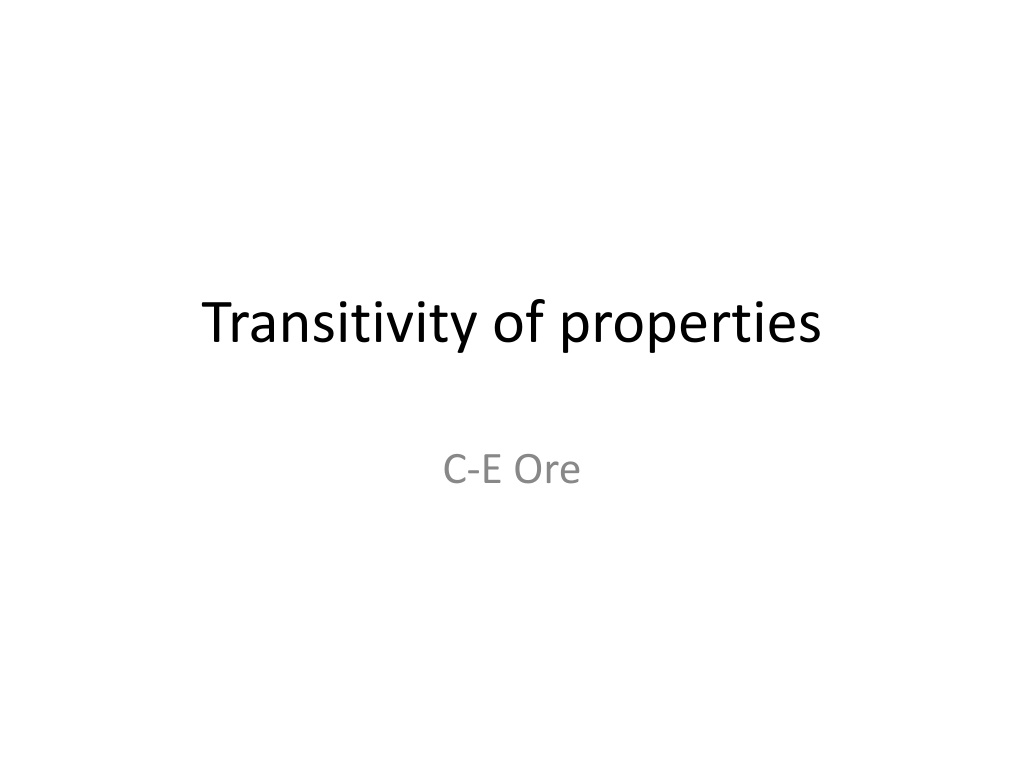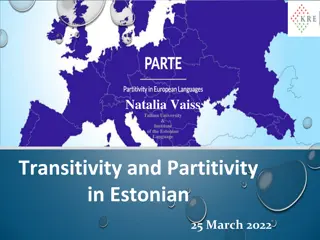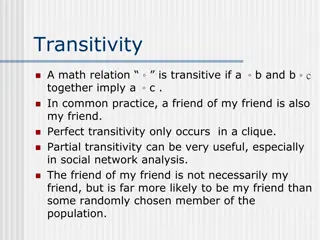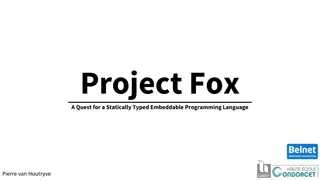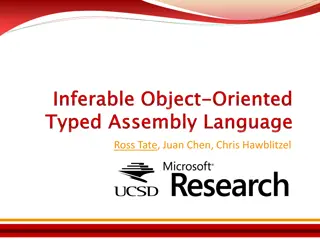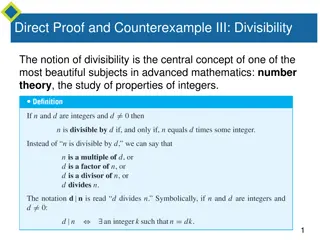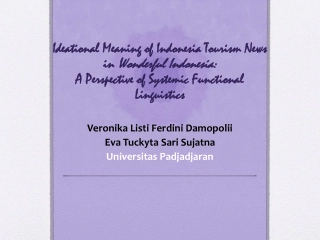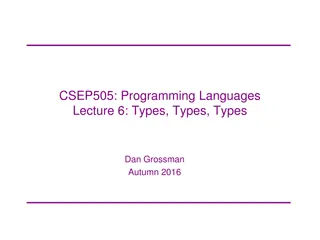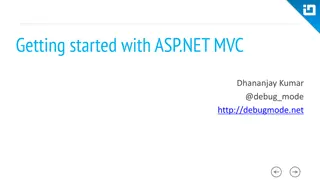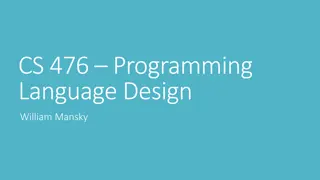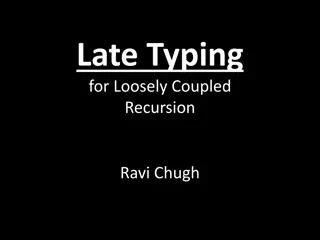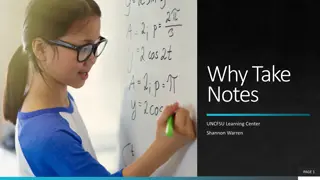Understanding Transitivity of Properties in Typed Systems
Exploring the concept of transitivity in properties within a typed system, this content delves into explicit and possibly transitive properties, showcasing how properties relate to each other and how they can be implicitly or explicitly defined. Through examples and explanations, the content provides insights into the relationships between different properties and how they are interconnected within a structured system.
Download Presentation

Please find below an Image/Link to download the presentation.
The content on the website is provided AS IS for your information and personal use only. It may not be sold, licensed, or shared on other websites without obtaining consent from the author. Download presentation by click this link. If you encounter any issues during the download, it is possible that the publisher has removed the file from their server.
E N D
Presentation Transcript
Transitivity of properties C-E Ore
Transitivity in a typed system Explicit x:A, y:A , z:A P(x,y) & P(y,z) -> P(x,z) Implicit or constrained Property P: A -> B & C subclass of or equal to A & C subclass of or equal to B & x:C, y:C , z:C P(x,y) & P(y,z) -> P(x,z)
Explicit, possibly transitive properties 1 P5 P9 consists of consists of YES EXP E3 Condition State YES EXP E4 Period E3 Condition State E4 Period P10 falls within YES EXP E4 Period E4 Period P134 continued NO EXP E7 Activity E7 Activity P69 has association with YES EXP E29 Design or E29 Design or Procedure E52 Time-Span Procedure P86 falls within YES EXP E52 Time-Span P89 falls within YES EXP E53 Place E53 Place P106 is composed of YES EXP E90 Symbolic Object E90 Symbolic Object
Explicit, possibly transitive properties 2 P114 is equal in time to YES EXP E2 Temporal Entity E2 Temporal Entity P115 finishes YES EXP E2 Temporal Entity E2 Temporal Entity P116 starts YES EXP E2 Temporal Entity E2 Temporal Entity P117 occurs during YES EXP E2 Temporal Entity E2 Temporal Entity P118 overlaps in time with NO EXP E2 Temporal Entity E2 Temporal Entity P119 meets in time with NO EXP E2 Temporal Entity E2 Temporal Entity P120 occurs before YES EXP E2 Temporal Entity E2 Temporal Entity P121 overlaps with NO EXP E53 Place E53 Place P122 borders with NO EXP E53 Place E53 Place
Explicit, possibly transitive properties 3 P127 has broader term YES EXP E55 Type E55 Type P130 shows features of NO EXP E70 Thing E70 Thing P73 is translation of YES EXP E33 Linguistic Object E33 Linguistic Object P132 overlaps with NO EXP E4 Period E4 Period P133 is separated from NO EXP E4 Period E4 Period P139 has alternative form NO EXP E41 Appellation E41 Appellation P148 has component YES EXP E89Propositional Object NO EXP E55 Type E89 Propositional Object E55 Type P150 defines typical parts of P152 has parent NO EXP E21 Person E21 Person
Implicit, possibly transitive properties 1 P1 is identified by NO IMP E1 CRM Entity E41 Appellation P48 has preferred identifier NO IMP E1 CRM Entity E42 Identifier P102 has title NO IMP E71 Man-Made Thing E35 Title P2 has type NO IMP E1 CRM Entity E55 Type P137 exemplifies NO IMP E1 CRM Entity E55 Type P15 was influenced NO IMP E7 Activity E1 CRM Entity P17 was motivated NO IMP E7 Activity E1 CRM Entity P136 was based on NO IMP E83 Type Creation E1 CRM Entity P20 had specific purpose NO IMP E7 Activity E5 Event
Implicit, possibly transitive properties 2 P62 depicts NO IMP E24 Physical Man-Made Thing IMP E89 Propositional Object E1 CRM Entity P67 refers to NO E1 CRM Entity P70 documents NO IMP E31 Document E1 CRM Entity P71 lists NO IMP E32 Authority Document E1 CRM Entity P129 is about NO IMP E89 Propositional Object E1 CRM Entity P138 represents NO IMP E36 Visual Item E1 CRM Entity P101 had as general use NO IMP E70 Thing E55 Type P103 was intended for NO IMP E71 Man-Made Thing E55 Type P105 right held by NO IMP E72 Legal Object E39 Actor
Implicit, possibly transitive properties 3 P51 has former or current owner incorporates NO IMP E18 Physical Thing E39 Actor P165 YES IMP E73 Information Object E90 Symbolic Object P107 has current or former member P140 assigned attribute to P39 measured NO IMP E74 Group E39 Actor NO IMP E13 Attribute Assignment NO IMP E16 Measurement E1 CRM Entity E1 CRM Entity P41 classified NO IMP E17 Type Assignement E1 CRM Entity P141 assigned NO IMP E13 Attribute Assignement NO IMP E91 Co-Reference Assignment NO IMP E18 Physical Thing E1 CRM Entity P155 has co-reference target P52 has current owner E1 CRM Entity E39 Actor
P134 continued (was continued by) Domain: Range: Subproperty of: E7 Activity. P15 was influenced by (influenced): E1 CRM Entity Quantification: many to many (0,n:0,n) E7 Activity E7 Activity Scope note:This property associates two instances of E7 Activity, where the domain is considered as an intentional continuation of the range. A continuation of an activity may happen when the continued activity is still ongoing or after the continued activity has completely ended. The continuing activity may have started already before it decided to continue the other one. Continuation implies a coherence of intentions and outcomes of the involved activities. Examples: the construction of the K lner Dom (Cologne Cathedral) (E7), abandoned in the 15th century, was continued by construction in the 19th century adapting the initial plans so as to preserve the intended appearance (E7)
P73 has translation (is translation of) Domain: E33 Linguistic Object Range: E33 Linguistic Object Subproperty of: E70 Thing. P130i features are also found on: E70 Thing Quantification: one to many (0,n:0,1) Scope note: E33Linguistic Object involved in a translation. This property describes the source and target of instances of When a Linguistic Object is translated into a new language it becomes a new Linguistic Object, despite being conceptually similar to the source object. Examples: Les Baigneurs (E33) has translation The Bathers (E33) In First Order Logic: P73(x,y) E33(x) P73(x,y) E33(y) P73(x,y) P130(y,x)
P139 has alternative form Domain: Range: Quantification: E41 Appellation E41 Appellation many to many (0,n:0,n) Scope note: This property establishes a relationship of equivalence between two instances of E41 Appellation independent from any item identified by them. It is a dynamic asymmetric relationship, where the range expresses the derivative, if such a direction can be established. Otherwise, the relationship is symmetric. The relationship is not transitive. The equivalence applies to all cases of use of an instance of E41 Appellation. Multiple names assigned to an object, which are not equivalent for all things identified with a specific instance of E41 Appellation, should be modelled as repeated values of P1 is identified by (identifies). P139.1 has type allows the type of derivation, such as transliteration from Latin 1 to ASCII be refined.. Examples: "Martin Doerr" (E41) has alternative form "Martin D rr" (E41) has type Alternate spelling (E55) " , " (E41) has alternative form "Gon arova, Natal Sergeevna" (E41) has type ISO 9:1995 transliteration (E55) has alternative form Athina has type transcription.
P148 has component (is component of) Domain: E89 Propositional Object Range: E89 Propositional Object Quantification: (0:n,0:n) Scope note: Object with a structural part of it that is by itself an instance of E89 Propositional Object. Examples: Dante s Divine Comedy (E89) has component Dante s Hell (E89) This property associates an instance of E89 Propositional In First Order Logic: P148(x,y) E89(x) P148(x,y) E89(y)
P150 defines typical parts of (defines typical wholes for) Domain: E55 Type Range: E55 Type Quantification: many to many (0,n:0,n) Scope note: A with an instance of E55 Type B , when items of type A typically form part of items of type B , such as car motors and cars . The property broaderPartitive associates an instance of E55 Type It allows Types to be organised into hierarchies. This is the sense of "broader term partitive (BTP)" as defined in ISO 2788 and broaderPartitive in SKOS. Examples: Car motors (E55) defines typical parts of cars (E55) In First Order Logic: P150(x,y) (E55 Type) P150(x,y) E55(y) The scope note is not well formulated
P15 was influenced by (influenced) Domain: Range: Superproperty of: E7 Activity. P16 used specific object (was used for): E70 Thing E7 Activity. P17 was motivated by (motivated): E1 CRM Entity E7 Activity. P134 continued (was continued by): E7 Activity E83 Type Creation. P136 was based on (supported type creation): E1 CRM Entity Quantification: many to many (0,n:0,n) E7 Activity E1 CRM Entity Scope note: between an E7 Activity and anything that may have had some bearing upon it. This is a high level property, which captures the relationship The property has more specific sub properties. Examples: the designing of the Sydney Harbour Bridge (E7) was influenced by the Tyne bridge (E22) In First Order Logic: P15 (x,y) E7(x) P15 (x,y) E1(y)
P17 was motivated by (motivated) Domain: Range: Subproperty of: Quantification: E7 Activity E1 CRM Entity E7 Activity. P15 was influenced by (influenced): E1 CRM Entity many to many (0,n:0,n) Scope note: reason for carrying out the E7 Activity. This property describes an item or items that are regarded as a For example, the discovery of a large hoard of treasure may call for a celebration, an order from head quarters can start a military manoeuvre. Examples: the resignation of the chief executive (E7) was motivated by the collapse of SwissAir (E68). the coronation of Elizabeth II (E7) was motivated by the death of George VI (E69) In First Order Logic: P17(x,y) E7(x) P17(x,y) E1(y) P17 (x,y) P15(x,y)
P136 was based on (supported type creation) Domain: E83 Type Creation Range: E1 CRM Entity Subproperty of: E7 Activity. P15 was influenced by (influenced): E1 CRM Entity Quantification: many to many (0,n:0,n) Scope note: evidence to declare a new E55 Type. This property identifies one or more items that were used as The examination of these items is often the only objective way to understand the precise characteristics of a new Type. Such items should be deposited in a museum or similar institution for that reason. The taxonomic role renders the specific relationship of each item to the Type, such as "holotype" or "original element". Examples: the taxon creation of the plant species Serratula glauca Linn , 1753. (E83) was based on Object BM000576251 of the Clayton Herbarium (E20) in the taxonomic role original element (E55) In First Order Logic: P136(x,y) E83(x) P136(x,y) E1(y) P136(x,y,z) [P136(x,y) E55(z)] P136(x,y) P15(x,y)
P105 right held by (has right on) Domain: Range: Superproperty of: E18 Physical Thing .P52 has current owner (is current owner of): E39 Actor Quantification: many to many (0,n:0,n) E72 Legal Object E39 Actor Scope note: Right to an E72 Legal Object. It is a superproperty of P52 has current owner (is current owner of) because ownership is a right that is held on the owned object. This property identifies the E39 Actor who holds the instances of E30 P105 right held by (has right on) is a shortcut of the fully developed path from E72 Legal Object through P104 is subject to (applies to), E30 Right, P75 possesses (is possessed by) to E39 Actor. Examples: Beatles back catalogue (E73) right held by Michael Jackson (E21) In First Order Logic: P105(x,y) E72(x) P105(x,y) E39(y)
P51 has former or current owner (is former or current owner of) Domain: E18 Physical Thing Range: E39 Actor Superproperty of: E18 Physical Thing. P52 has current owner (is current owner of): E39 Actor Quantification: many to many (0,n:0,n) Scope note: owner (i.e. title holder) of an instance of E18 Physical Thing at some time. This property identifies the E39 Actor that is or has been the legal The distinction with P52 has current owner (is current owner of) is that P51 has former or current owner (is former or current owner of) does not indicate whether the specified owners are current. P51 has former or current owner (is former or current owner of) is a shortcut for the more detailed path from E18 Physical Thing through P24 transferred title of (changed ownership through), E8 Acquisition, P23 transferred title from (surrendered title through), or P22 transferred title to (acquired title through) to E39 Actor. Examples: paintings from the Iveagh Bequest (E18) has former or current owner Lord Iveagh (E21) In First Order Logic: P51(x,y) E18(x) P51(x,y) E39(y)
